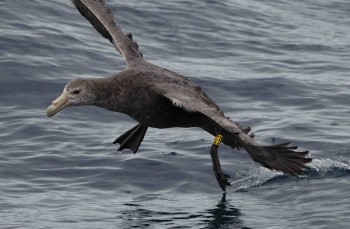On 13 September a colour-banded Southern Giant Petrel Macronectes giganteus was observed from South Africa’s Antarctic supply and research ship, the m.v. S.A. Agulhas II while at anchor off the island of Tristan da Cunha in the South Atlantic.
The bird was photographed through a 500-mm lens as it flew towards the vessel. Checking the photo later showed that the colour band was yellow D75, identifying the bird as coming from the demographic study colony below Low Hump on Gough Island’s west coast.
Two days later we landed on Gough and looked up the bird’s details and history. Turns out it is a female and was incubating its egg in the Low Hump colony only five days previously. Tristan is 380 km north-west of Gough, so this distance is clearly within the at-sea foraging range of an incubating bird.
Previous colour-banded giant petrels from Gough seen in Tristan waters have nearly all been females (click here), reflecting the well-known differences in foraging behaviour between the sexes, with females foraging more at sea, while males forage mainly onshore in seal and penguin colonies.

Yellow D75 photographed off Tristan da Cunha by Peter Ryan
Research on ACAP-listed species on the outer islands of Tristan da Cunha is funded by the UK's Overseas Territories Environment Programme and the Darwin Initiative Programme via the Royal Society for the Protection of Birds and by the FitzPatrick Institute, University of Cape Town. It is conducted with the support and approval of the Tristan Conservation Department and the logistic support of the South African Department of Environmental Affairs.
John Cooper, ACAP Information Officer & Peter Ryan, FitzPatrick Institute, University of Cape Town, 16 September 2013

 English
English  Français
Français  Español
Español